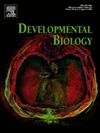Shh signaling directs dorsal ventral patterning in the regenerating X. tropicalis spinal cord
IF 2.5
3区 生物学
Q2 DEVELOPMENTAL BIOLOGY
引用次数: 0
Abstract
Tissue development and regeneration rely on the deployment of embryonic signals to drive progenitor activity and thus generate complex cell diversity and organization. One such signal is Sonic Hedgehog (Shh), which establishes the dorsal-ventral (D/V) axis of the spinal cord during embryogenesis. However, the existence of this D/V axis and its dependence on Shh signaling during regeneration varies by species. Here we investigate the function of Shh signaling in patterning the D/V axis during spinal cord regeneration in Xenopus tropicalis tadpoles. We find that neural progenitor markers Msx1/2, Nkx6.1, and Nkx2.2 are confined to dorsal, intermediate and ventral spatial domains, respectively, in both the uninjured and regenerating spinal cord. These domains are altered by perturbation of Shh signaling. Additionally, we find that these D/V domains are more sensitive to Shh perturbation during regeneration than uninjured tissue. The renewed sensitivity of these neural progenitor cells to Shh signals represents a regeneration specific response and raises questions about how responsiveness to developmental patterning cues is regulated in mature and regenerating tissues.

Shh信号在再生的热带棘猴脊髓中指导背腹侧模式。
组织发育和再生依赖于胚胎信号的部署来驱动祖细胞活动,从而产生复杂的细胞多样性和组织。其中一个信号是Sonic Hedgehog (Shh),它在胚胎发生期间建立脊髓的背-腹(D/V)轴。然而,这种D/V轴的存在及其在再生过程中对Shh信号的依赖因物种而异。本文研究了热带非洲爪蟾蝌蚪脊髓再生过程中Shh信号在D/V轴上的功能。我们发现,在未损伤和再生的脊髓中,神经祖细胞标记物Msx1/2、Nkx6.1和Nkx2.2分别局限于背侧、中间和腹侧空间域。这些结构域会因Shh信号的干扰而改变。此外,我们发现这些D/V结构域在再生过程中比未受伤的组织对Shh干扰更敏感。这些神经祖细胞对Shh信号的新敏感性代表了再生特异性反应,并提出了关于成熟和再生组织如何调节对发育模式线索的反应的问题。
本文章由计算机程序翻译,如有差异,请以英文原文为准。
求助全文
约1分钟内获得全文
求助全文
来源期刊

Developmental biology
生物-发育生物学
CiteScore
5.30
自引率
3.70%
发文量
182
审稿时长
1.5 months
期刊介绍:
Developmental Biology (DB) publishes original research on mechanisms of development, differentiation, and growth in animals and plants at the molecular, cellular, genetic and evolutionary levels. Areas of particular emphasis include transcriptional control mechanisms, embryonic patterning, cell-cell interactions, growth factors and signal transduction, and regulatory hierarchies in developing plants and animals.
 求助内容:
求助内容: 应助结果提醒方式:
应助结果提醒方式:


